
TAKASHI
KURIBAYASHI
Kuribayashi often says, "The truth resides in places that are invisible. Once you are aware of that there is a different world out of sight, you will be living in a different way." The invisible realm and its boundary is Kuribayashi's main them throughout his career. He has been creating special installations that visualize things that cannot be seen in the daily life, such as behind the ceiling, floor, or seabed, so that he can reveal this invisible world.
The Great East Japan Earthquake 3,11. 2011, became a tremendously strong boarder that are absolutely different level of lived. Since then, he has been challenging the issues that are absolutely different level of hardness: completely invisible radioactive contamination triggered by the tsunami and the following Fukushima nuclear accident, the boundaries of the restricted area in the region, and the invasion of nuclear activites in the underground that we do not even have a way to confirm what actually happens. He has also been to various kinds of boundaries of the world. In his Yatai Trip, which are for him tactile experiences of the earth and also processes of creating maps of the world including Japan in various materials. While approaching the boundary of the life of the earth and of the time and space beyond the death, Kuribayashi rediscovers the wisdom of the ancestors, cooperates, and dialogues with the sages in our era. This is a challenge of arte of life for us. This is art that will be passed down to the future.
30年以上、私は物事と物事の間、また色々な場所や空間にある境界、または境界線 に興味を持ち、それらをテーマとして作品製作をしてきた。1989年のベルリンの壁が崩壊した直後にドイツに渡り、そして1990年代のEUの設立、壁が壊され国境がなくなり、境界が変化する様を目の当たりにして来た。島国である日本では決して味わえないその環境に身を置くことで、逆に日本の境界は海である、ということを強く再認識させられ、その海に自分が育てられてきたことに気づかされることとなる。
その海の境にも、水面という境界が存在する。水面は水中と空中に分けられ、我々が空中に生きている生き物であることに気づくのだ。そしてそれらの間に存在するや空間や曖昧さをアートという媒体を通して人々に伝え、多くの境界でトラブルや事件が起きること、そこに大きな力が集中していることを表現し続けてきた。今、我々人類は新しいフェーズに入ろうとしている。
人類の歴史を紐解くと、必ず100年前後の周期で大きな活動が起き、変化がもたらされる。まさしく今はその変化の境界の時代であり、世界的に大きな変動が起きようとしている。また、自然界はその度に我々人類のワガママに付き合わされ、とばっちりを受け、苦しんできた。しかし彼らはそのことに捉われず、「生きる」ということに純粋に向き合い、生に対し本能的に対応し続けてきたのである。我々人類は、地球という環境においては、癌と同じ様な有害な生物なのだろうか。いや、癌にしろ、人間にしろ、それ自体は自然の一部であり地球の一欠片なのである。
我々人類が自然環境を守ろうなどとはむしろおこがましいことであり、我々人類という生物は、今一度地球の一部であることに目覚めるべき時が来ているのではないのだろうか。
2020年のコロナを含め、大きな環境やシステムの変化の可能性を見るにつけ、戦後、いや、むしろ明治という時代以来なのかもしれないが、この資本主義というイデオロギーではなく、自然主義、とも言うべきか、日本本来の環境と共に生きる生き方を再確認、活用する時代に入る時が来ている。これからのプロジェクト達がその始まりの一つとしてのきっかけであり、活動であり、そして象徴として存在できるならば、これからの新しい時代への大きな宣言になることに他ならない。
我々人類は、境界線を越えて、新しい時代を選択するとても重要な時期に来ているのである。
works




Barrels 2024 (Tanker Project)
Roots/Takashi Kuribayashi
2.9m x 8m x 2.5m
wood ,glass, barrel, mixed media
A tree floating on a drum.
The tree is divided and each piece is placed in a glass box. Within each glass box, a different ecosystem is born, creating a new universe.
The drum contains vegetable oil, which reflects the image of the other half of the tree, reviving the memory of the tree. An installation that pursues the source of




Botanic GENKI-RO
ALTERNATIVE-STATE#3
Beppu Oita 2024
4.0m x 5.5m
cypress wood ,glass and a lot of kind of plants.
this uniquely shaped botanical garden is an artwork that grows alongside the heart of every visiter this "Botanic GENKI-RO"thrives as visitors fill it with kindness and positive energy, returning the power to them as it foster interactions and new narratives.




Ohya Genki-Ro No.06
former Ohya stone quarry site
Ohya Tochigi 2023
18m x 17m x 8.5m
wood , mirror, glass and mixed media
The roots of an old tree are enshrined in the old quarry site. After passing through a corridor of mirrors, you will come across a pile of huge stones weighing up to 4 tons. There is a building made of cypress. Inside, the herbs from the cauldron outside are sent to create a pure white space, and people can experience being inside it.




GARDEN Klakat Bali
Indonesia Bertutur 2024
2000mm x 2000mm x 3000mm
Metal , Glass, Plant and Mixedmedia
We all have a "garden" in our hearts. You have to growing it yourself. You have to till the soil, plant the seeds, and keep watering them. your own garden. It is imagined, thought and realized in the mind. “Garden of the heart. “ It is an important thing that allows people to live a wealthy our life.




out of the mosquito net
document fifteen 2022
Roppongi art night 2023
6.7m x 6.7m x 5.2m
wood , mixedmedia
mosquito net
The choice of material is inspired by the Japanese idiom ‘kaya no soto’ or ‘out of mosquito net’
which corresponds in usage to the English “out of the loop” Instead of practicing exclusion, the project invites unforeseen audiences into the mosquito net and evolves in dialogue with local contributors as it drifts around Kassel.
Exemplifying the lumbung sprit informing documenta fifteen, Takashi Kuribayashi’s projects cumulatively point to the caravan as a model of community where individuals retain their autonomy while each contributing in their own way to an unfolding experience of togetherness.




Mountain range
Tokyo Midtown Yaesu 2022
4.5m(height) x 10m(langes)
x 5m(width)
mixedmedia
permanent work
Using the original soil from the Japanese archipelago, from north to west, create strata using a construction method called Hanchiku(rammed earth).
The gray soil in the middle is the soil from 30 meters below this site.




GENKI-RO /OHYA No.2
UNDER MUSEUM PROJECT
Challemge 01 GATE
7m(height) x 11m(width)
wood glass
inside herbal steam sauna
ohya-town
ohya-stone quarry site
utsunomiya Tochigi Japan
solo exhibition and gloup exhibition
Rai shizuno & Takashi Kuribayashi




GENKI - RO / First machine No. Zero
8m x 8m x 6m70cm
wood
inside Herbal steam sauna.
Nizayama Forest Art Museum,
nyuzen-cho Toyama Japan
solo exhibition
Takashi Kuribayashi
"GENKI-RO" (meaning Energy Plant, rhyming with GENSHI-RO, meaning Nuclear Reactor). Takashi Kuribayashi has been regularly visiting Fukushima for research since the Great East Japan Earthquake. This year after 10 years since nuclear accident, he decided to create a work imitating the shape of a nuclear reactor at the opportunity of showing at Power Plant Museum which has a relation with energy. Checking the internet about the shape of the reactor, the power plant in Fukushima, built in the 1960s had second-generation reactor,
"What if all the people who entered the reactor came out in good spirits?" According to the artist, the work at the Power Station Museum is an attempt to positively express the negative nuclear power problem. Hot water is boiled with herbs in a stove outside the museum and send the steam into the work through a pipe. Visitors are invited to go inside the work, and when the temperature inside exceeds a certain average (meltdown), the audience immerses themselves in the cooling water stored under the floor as if they themselves were control rods. Unfortunately, the day we visited the stove was not turned on, but with the similar system like sauna, the person at the museum explained us that there are many audience who actually come out from the work feeling themselves being refreshed. According to the museum staff member, steam makes the inside all white, without being able to see a meter ahead. That experience must be also be impressive one, but still even without the steam, the scale of the work was a very powerful enough.
This kind of work using fire is almost impossible to be exhibited in most of museums, but result of Kuribayashi’s artistic power to realize something which is almost impossible and ridiculous, if it isn’t art. It may initially seems to have nothing to do with the esoteric nature frequently found in contemporary art, but it still has a sharp edge in common, clearly showing humorous impression on the outlook side while giving a glimpse of the cynical edge fully hidden in the pockets.








Tree of Ibuki 2019
"Setouchi Art Triennale 2019"
6m x 8m x 5m
metal , Japanese cypress and mirror
When the young man Takashi Kuribayashi travelled alone to Germany to study, he was confronted by the following questions posed by his teacher: "Who you are? What you are? The long days that he spent grappling with these questions become the boundary from which his identity as the artist Takashi Kuribayashi was born.
Having grown up by the sea of Hirado in Nagasaki Prefecture, Kuribayashi came to the realisation that separating the underwater world and his own world as a human being was the boundary line of the water's surface. In this embodied experience of the existence of two completely different worlds, one above and the other below the surface of the water, lies the origin of the theme of "boundary that has pursued as an artist. Kuribayashi's works have expanded viewers imaginations by suggesting the existence of unimagined words existing behind ordinary boundaries such as walls and ceilings, or the worlds beyond imaginations in domains often unnoticed in everyday life. This is linked to his long-running Yatai Trip Project, now in its tenth year, in which Kuribayashi travels to the actual borderlands that define countries, nations, and the limits of human habitation. Here he creates artworks that show that the apparent borders that separate the countries on the earth actually have no real existence.
Kuribayashi's artistic exploration of boundaries has been confronted by the concept of "restricted zones" or "no-go areas in the aftermath of the Fukushima nuclear accident. Faced with such an impossibly long-lasting and yet invisible border, he has set himself on a quest to reverse and weave anew the flow of time.
Secking the possibility of transcending time, whether in words that are repeatedly uncarthed and buried again, or in the ceaseless movements of nature, Kuribayashi has returned again to the questions: "What is the purpose of making art? Why am I an artist? This internal conflict has reappeared, perhaps, in the wake of establishing himself as an internationally active artist in Yogyakarta, Indonesia, further opening his eyes to the wider world and becoming more keenly aware of its contradictions. In other words, he has the courage to embark on an eternal journey reflecting upon his existence freely and honestly.
This has led him to the figure of the niwashi, a gardener of the mind'. who waters the minds of children growing up in the city and young people living in contemporary settings, helping them cultivate the consciousness that they themselves are seeds and that they can sprout and grow. Niwashi is also the person who would give a different set of values amidst a society which only offers anxieties.
Starting from the end of September, for the autumn iteration of the Setouchi Triennale 2019. Kuribayashi will create and present his work at the debeya in Ibukijima, a place he felt a strong attraction to. The debeye was a space where for over four hundred years the island's expectant mothers spent a month before and after giving birth. Every baby inherits the legacy of three billion years of life. It is a form and memory of life that has been passed down in this ever-changing carth Childbirth is a precious boundary of life. Ibuki no Ki (Trees of Ibuki)" projects this memory of life as a light glowing like a kaleidoscope. Could it be an invisible thread that brought Kuribayashi to this island which just happens to be the place where his mother was born?
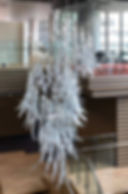

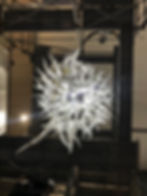

Tornado / Tiger 2020
Tiger Corporation Headquarters
2020
7m x 3m x 3m
600 kg glass chandelier with 60 pieces of glass
7m long.hanging from ceiling.
The title is "Tornado".
It involves everything and rises.
The root is a roots of all things and wound around the vortex.




Entrances 2018
"The connection between the sea and the sky"
palais de tokyo Paris
Saison Enfance
6m x 90cm x 3trees
5mm 7000 sheets one side mirror, tape,
light box, mixedmedia
“Frontiers are everywhere. In human societies, but also in nature. They are the places with the greatest concentrations of energy.”
Takashi Kuribayashi’s works display his curiosity about the variety of frontiers that cut up and separate the world. Entrances (2018) is an installation made up of three trees made of strips of one-way mirrors. If the differences of perception between one side and
the other of the mirrors evokes this idea of a frontier, this new work also reflects the artist’s interest in ecological issues, as seen
in his work in recurrent natural iconographic patterns. This interest intensified in his works after the accident at the Fukushima nuclear power station in 2011, following a tsunami set off by a violent earthquake. In the hands of the Japanese artist, trees become industrial and synthetic, their leaves crystallised into mirrors with kaleidoscopic reflections. Viewers passing their heads and raising eyes inside the trunks discover three photos of skies taken through the surface of water in different places of the planet. Seeing or not seeing the catastrophe, a one-way mirror also evokes our desire to hold into our multiple reflections, to see through or beyond, or else to pay attention to other viewpoints.
A forest is also a symbolic trial in initiatory narratives. It is place where often appear strange beings, but also a space where markers are extended, favouring isolation and the wandering that leads to all forms of self-construction in a presentation of the passage towards adulthood in tales.




Daiichi Kurobe Dam Onsen
Japan Alps International Art Festival 2017
JAPAN ALPS ART FESTIVAL 2017
-Shinano-Omachi Food and Art corridor- (http://shinano-omachi.jp )
10m x 21m x 6m
original soil from Nagano Shinmachi
The artwork of Takashi Kuribayashi has been exhibited in “Downtown Area” of Shinano-Omachi. Kuribayashi dismantled the 120 years old draper shop and created the model of 1/40 of Kurobe Dam in the building. He used the mud wall and several kinds of local soil of Nagano to create the powerful dam of 8m (w)×4.5m (h) with the traditional method of construction, Rammed earth. He also recreated the mountains of Northern Alps and established the footbath section in a part of the lake to make his guests enjoy the artwork.
.




CAN NOT SEE
DO NOT SEE
DO NOT WANT TO SEE
PRAY
The nuclear reactor is like a huge animal, whose wisdom is far beyond that of the human, but at the same time, is the strongest artifact made by the human. What is beyond the human wisdom creates a religious belief, to which people look up, and prayers begin. The religious belief is originated in depending on a feeling of awe, which is elicited from fear felt when people encounter what is beyond their imagination.
By the nature of the nuclear reactor, it includes a duality that can be both God and the devil. There is only a fine line between God and the devil, as being back-to-back, from ancient times.
Religion and the energy are extremely closely related. In Japan, the names of Bodhisattva are used for the nuclear reactors.“Monju”(the fast breeder prototype reactor) is named after the Bodhisattva symbolizing wisdom, and “Fugen” (the advanced thermal reactor) is named after the Bodhisattva symbolizing ascetic practices. The shape of the reactors overlaps with the shape of Buddha, in which people seek for the mercy of “Gautama”. The image of the nuclear reactor overlaps with Buddhism that began cremation first. Both the ideas of the nuclear fuel cycle and the cycle of reincarnation are what last eternally.




Vortex 2015
“A letter from Einstein”
Spiral Garden Aoyama Tokyo,
NADI Gallery Jakarta
glass, wire.
2300mm x 2100mm
Confronting the invisible at a
shrine of black flexible containers
Takashi Kuribayashi conceived this artwork when he witnessed the scenery of so-called ”flexible container” bulk bags piled up after the Fukushima nuclear disaster. Even though they are handling soil containing radioactive materials with a half-life of over 30 years, the bag materials themselves only last 3 years. Kuribayashi’s shock at this, as well as the sheer volume of the materials, inspired him to re-examine humanity closely. Created out of a concept distinct from his previous work, this is the artist’s response to the question of what is visible and what is invisible, a constant theme in multiple religions since time immemorial.
The cuboid flexible containers oppress the viewer, perhaps flexible containers oppress the viewer, perhaps evoking architecture that encompasses the sublime and the intangible, such as the Kaaba, the sacred Islamic site, inside, something is hidden, like it has been blocked off with a black wall. We are gripped by the desire to see it and, by peeping from a place where the wall is open, discover a chandelier of glass words that emit light. There are sentences from a letter, sent by Einstein to Roosevelt requesting permission to develop the atom bomb. But since it is mirror writing, we cannot read it clearly. To read what the words are saying, we have to turn and “read” the shadows.
Within the vortex produced by our desire towards what is invisible, what is revealed, what is hidden, and what we see, and our avoidance of what we do not want to see, this artwork lingers authoritatively, like a void engendered in the center of gravity. It is like it is alerting us to the strength of being swayed by neither pole in a confrontation.




Trees 2015
Singapore Art Museum (SAM) at 8Q
Imaginarium / a Voyage of Big Ideas
14 March - 19 July 2015
Artist Takashi Kuribayashi found a tree that had been chopped down to make way for redevelopment. To create this installation, he put the cut-up sections of the tree trunk into glass boxes. The remaining glass boxes are filled with leaves and small plants that the artist found in Singapore, so that when viewed from a certain angle, the glass boxes collectively form the image of a whole tree. The image of a tree contained within glass boxes is also a reference to how nature often exists in very controlled environments in cities such as Singapore. Over time, the sections of the tree trunk will decay, and in the process give life to new organisms and ecosystems, so that each glass box will hold a tiny new world of its own.

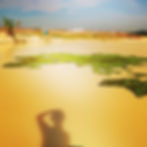


ISLAND
2014 Wonderfruit, Pattaya Thailand
made water plant from that place.
after few year water plants go break the world.
World map made by water plants that inhabit floating in the pond.
Water plants is growing as time goes on, it will change the shape of the world map.
This work is to be conscious to us, change of boundaries in modern and border unrelated to the creatures that it's human selfishness.



principal office is a symbolic place of power and adult world. I wanted to stop time of the space and show the place. In addition, because it is an old building, a lot of moisture is contained in the air. The water content varies depending on various places. I thought, by freezing the air in the space, I would be allowed to visualize the things you can not see in our eyes. Japan has lots mercy of things that are invisible to the naked eye especially after 3.11.2011

Principal office 2014
21.March ~ 11.May 2014 ,
works in old elementary school "Satomi-sho"
Chiba Japan
open at 9:30am~5:00pm
ICHIHARA ART-MIX TRINENALLE 2014
The principal office that is no longer used, is frozen to minus 35 °C below, along with the stop time, work to visualize the air in that space.
We Japanese have the ethnicity that has a strong consciousness to what is invisible. But since March 11, 2011, such as to divert your eyes from that you understand even without is also seen what it appears, does not see it because we don’t want to see, or would not have become the trend that.
By the visible what is usually invisible, and to define a new problem.



I wanted to show the time, boundary, truth and Nature. I used popular leaves from an area. The ground is also the boundary line between the ground and the ground of us. We have to look to the time and day and age through the our sight from the ground. By considering the things through different eyes and different perspective, we can see the truth, In addition, from 3.11.2011,rain has changed in Japan. It had because a rain of invisible death,to penetrate the ground, i created a base for us.

Underground Sound of Rain 2013
|
|
"Threshold | Ambang" A solo exhibition by Takashi Kuribayashi |
http://www.selasarsunaryo.com/
sewed thousands of leaves he picked up from the garden, and hung them from the ceilings. The work is titled Underground Sound of Rain (2013). The intertwining leaves form a draping overlay that reminds us of a green-brown colour fabric with undulating contours – visually, this creates a dynamic effect. It is akin to leaves that fell onto the surfaces of a hill, only to be pulled back simultaneously by a strong magnetic force from the sky, the leaves draping as they float across the exhibition space. The range of nylon fabrics that bind the leaves presents themselves as beaming white vertical lines that drop from the ceilings of the gallery walls.
In many of his works, the viewers’ interaction within the exhibition space is an important aim to be achieved. Installation is used simply to ignite various bodily and gestural responses hoped to occur unexpectedly. To enjoy the work Underground…, for instance, viewers must walk in and gaze above them in order to view the bottom of these hovering leaves – imagine that you are a worm or an ant crawling on the surface of the land, slipping underneath the leaves to run away from the threat of predators. he also creates a number of holes so that viewers can put their heads or half of the bodies through them, as if emerging from the surface, and immerse themselves in the view of the sea of leaves (imagine yourself as a dormouse coming out of your nest to enjoy fresh air and the warm rays of the sun after long periods of hibernation).
Agung Hujatnikajennong Exhibition Curator.




Wasser Wände (water wall)
Sky Over My Head,
Contemporary Art Museum Kumamoto.
Kumamoto Japan
There are dual spaces that necessarily exist in the world in which we live.The sea in opposition to the land, the land in opposition to the sky,inside and outside,reality and unreality, nature and non-nature,etc. We human beings live in a position that straddles such dual worlds. How much space can be handled by an individual human being? It is not very wide. We have invented tools and developed them to create civilization, but I believe we have become intoxicated with technology, puffed up with success, and gone too far. I investigated how much space can be handled by one person with his own body by standing on top of a 4000-meter mountain in the Himalayas on Murch 10, 2011 and then by diving under water. the place where I live. We should stop and think. About the place where we live.




Wald aus Wald (Forest from Forest)
2010 Sensing Nature, Mori Art Museum.Tokyo
2011 Art Stage, Singapore
2011 IN BETWEEN, Beyond Museum. Seoul
South Korea
2011 Lost & Found, Hong kong Art Center.
Hong kong
2012 Mediations Biennale 2012. Poznam Poland
2013 The unknoun kunsthalle faust
Hannover
Awagami Factory
The white trees that appear to float in the gallery space have been molded by Artist from japanese larch trees in Yamagata, using Awa washi (handmade paper). Having taken on the from of trees, the washi, which is made from natural materials such as kozo(hybrid mulberry tree) and mitsumata(paper bush), has become a symbol of the ecology of our natural world. Peer out through a crevice at the world that lies above the ground, and observe the forest from an insect's perspective
(The installation work is by which was made with the Japanese paper made from a paper mulberry. When you enter from an entrance, it mean to enter paper in a lower part, that can't do any understanding. When your face put in a hole paper , white larch woods are spread there. that the ground is one of a boundary line makes them understand and paper also is made of a tree, make them confirm that natural is the part. )




Wolkenmeer (sea clouds)
water >|< wasser,
Towada Art Museum. Aomori Japan
2012
The installation art that a world map made of 40 t of black soil from Towada comes out when mist was generated. Looking from the side,it is a simple mountain, but aier a while is filled with mist and surrounds a mountain.
The boundary becomes the world map when you look at a moment filled with mist. The work which showed ambiguity of the boundary of our world.




Trip Museum
2012 water >|< wasser , Towada Art Museum
Aomori
2012 Umi Festa Onomichi2012, Hiroshima
2012 Sotome Trip Museum 2012, Nagasaki Art
Project. Nagasaki
The Project that a part of the Towada Art Museum moves.
The mobile art museum becomes the fridge and gets cold to below -20 degrees.
It let a thing or the space freeze from place to place and stop the Pme, and make it a 3D work.
In addition, there is the another purpose to shorten the distance between people and “art” by carrying the special space called the art museum to the local place, and having everyone participate.




Inseln (island)
Sensing Nature ,
2010, Mori Art Museum Tokyo Japan
Japan's shape is drawn as the boundary that lies between land and sea. However , this is an ambiguous boundary that repeatedly changes with the ebb and flow of the tides or as a result of other natural phenomena. In this work, a flat map of the world is spread over the peak of a 4-meter mountain. The boundary between land and sea no longer represents a national border, instead hinting at the boundary that lies between man and nature. This view of the world, in which the land mass simply spreads downwards, is also reminiscent of the geocentricism of ancient times, in which people believed that the heavens existed above a flat Earth.




Tornado 2012
wasser >|< water,
Towada Art Museum.Aomori
new border
Film: Fukushima between 20km
14:09 min
Due to the Fukushima Daiichi Nuclear Power Plant Accident
the areas within 20km radius from the plant had now become
designated "eracuation zone" where they could be ordered to
leave and never to enter.




Erde (Earth)
Take Action, Hidetoshi Nakata Revalue Nippon
2012, Project, Osaka
Awagami Factory
The project reconsiders traditional Japanese culture by Mr. Hidetoshi Nakata. 5 artsts participate with the theme of the Japanese paper that year. This work is upturned a globe. When you look at the inside from the South Pole, a conventional world map appears. The work which makes the angle of change usual trying to judge the world by which from the back. It is made of Japanese pure paper.




INVISIBLE
2013 Chelsea College of Art and Design London TWS artist in residence program 2013
2013 sea+triennale 2013 Jakarta
2014 Project de intercambio cultural Sao Paulo-Tokyo
After March 11, 2011,
people are turned away from the truth eye.
Do not see, do you not see, or do not you want to see. Visualization of the fact invisible.
It is moved by something we can not see.




Icicle 2011
2011 IN BETWEEN,
Museum Beyond Museum. Seoul, South Korea


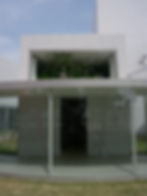

Sumpf Land (Wetland)
2006, towada art center
Aomori Japan
http://towadaartcenter.com/web/top.html
What he proses in this worlk, entitled Sumpf Land, or "marshland" in German, is the "boundary phase" of two worlds. His work has long dealt in this "boundary" theme by installations which integrate dipperent spaces into his installations, such as bisecting walls, or extending through roofs. Boundaries, of course, include more than obvious national borders, but originate in our minds, in the implicit preconceptions which shackle our thinking. The larger intention of his work is to provoke different perspectives on things, to suggest new way of looking at things. artist is an avid diver and marine sportsman, and these experiences of communing with nature provide an important background for this work, both in the he often uses water, and living, changing materials found in nature.




Neoplane
Pinguins & Seals
2000 under water project, penguin swim.
phuket Thailand
2003 Artothek Kölnishes StadtMuseum. Köln Germany
2003 out of the blue, Tokyo Wonder Site. Tokyo
2004 Adventure at/of the Museum. Hiroshima city Museum. Hiroshima
2006 Root Culture, Marine Animal Story.
Kanagawa
2006 Klasse Kamp, Kunsthalle
Düsseldorf.Düsseldorf Germany
2006 Gardens, Toyota Municipal Museum of Art. Aichi
2009 Maison Hèrmes Window Display.Tokyo
2012 Sanyo& More Trees project, wasser >|<
water. Towada Art Center Aomori
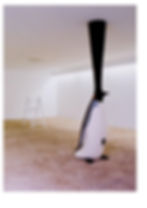



Emperors Welt (Emperors World)
out of the blue
2003, tokyo wonder site, tokyo Japan
http://www.tokyo-ws.org/english/
A penguin made with wetsuit is placed in the middle of the room. If you go up a stepladder behind the penguin, the water surface is spread throughout the arc.
You can see what is inside the penguin’s hand.
A calm lake shore appears before your eyes, which will take you to another world by purng your hand into the ceiling.




Kleine see (Small Pond)
National Museum of Singapore ,2007
A small pond is suspended in mind-air in what is usually an atrium at the entrance of the museum. Visitors enter the museum as though entering the pond before proceeding to view the exhibition. The work is structured so that the museum seems to exist inside the pond. This was the first time that the artist used artificial plants exclusively. Visitors , however, who have seen Artist's previous installations featuring real plants, are convinced that these, too, are real, until the installation challenges their assumptions.




Aquarium
(I feel like I am in the Fishbowl)
2006 Singapore Biennale
Tanglin Camp ,Singapore
2011 inbetween
museum.beyond museum,korea
As you go into the building, you’ll find an aquarium in the middle, and a face appears in it. If you want to enter the aquarium, you have to go out the building once, and go under the floor to put the face in it. People, who watch the aquarium, actually are watched by the others. This installation art represent the relation between both side of watching and being watched.
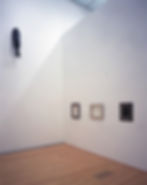



Divider/ Washstand
2006 Gardens
Toyota Municipal Museum of Art, Aichi Japan
2008 Aoba Art 2008,
Tamaplaza ,Kanagawa ,Japan
2007 New Nature,
The Govett-Brewster Art Gallery, New Plymouth,New Zealand 2007 Art / 38/ Basel,Switzerland
This is an art that you look inside of the frame on the partition wall. You may look inside of a picture practically, by using the frame which surrounds a picture. It makes you understand that the partition wall is a part of a museum.




Himmel Oberfläch
(Sky Surface)
Magickisland, Belgium and Germany
National border of Belgium and Germany
For those living on land, the boundary between the water and sky is thought of as the surface of the sea, or water. For creatures living underwater, including amphibians such as penguins and seals, this same boundary would be thought of as the "surface of the sky." This work takes that concept as its title, and consists of the Japanese national border created on the roof of a bilding on the border of Germany and Belgium that had been used for years as a passport checkpoint. The idea that a national border is a boundary between land and sea doesn't exist in Germany, where kilometers of concrete barriers built during the Nazi era remain to mark the border today. In this work, I depicts the difference between the concept of the border in Germany, where these structures bear witness to the border, and in Japan, where the national border is represented by the boundary between land and sea.
VIDEO INSTALLATION
WE HAVE DECIDED NOT TO DIE 2016
It happened on March 11, 2011, the Great East Japan Earthquake.
Happened in its influence, Fukushima first explosion of a nuclear power plant.
Month of five years is going to passed since from there. However, still the situation has not changed. Nevertheless, in the world, it is a reality is being treated like a past thing. This work, there is a home in the feedback difficult areas within Fukushima Prefecture Futaba-gun Tomioka, even now while the raising work Standing a company in Iwaki City, is a documentary of the man to continue home care.Writers, three times from twice a year than in 2011, visited the interview to near the Fukushima nuclear power plant, it has been told a lot of facts. This time, by the encounter with this man, the local people thought, is a strong will of to the future of people, of Shusaku Arakawa and Madline Ginzu
"WE HAVE DECIDED NOT TO DIE"
synchronized with the word, I will cast their will to live there and still follow Fukushima reality.